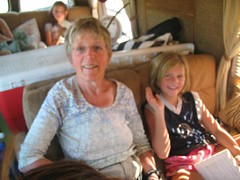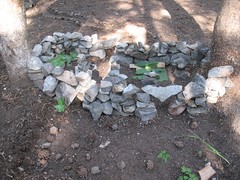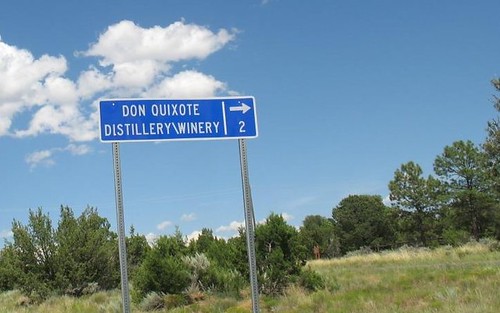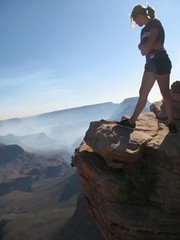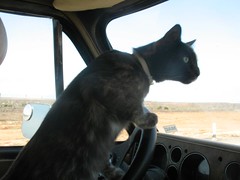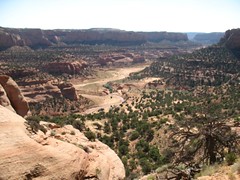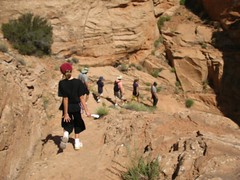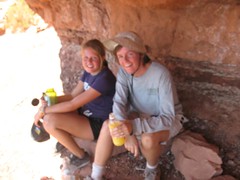DrC glances at me as squeals and giggles pour out of the shower. In the interest of saving water and money, my mother and my youngest child are sharing a six minute shower at the campground bathrooms. I shrug, Whaddaya gonna do? They're having fun.
Aeron and Grandmother Sue have become inseparable during this long road trip. They sit together in the center passenger seat of the van as we travel, Aeron chattering endlessly and my mother occasionally attempting to stem the tide with a comment, pat or imprecation. At camp, they read side-by-side on a park table, work together cleaning dishes, or wander off to brush their teeth. When DrC, Jaime, Mera and I head out to tackle strenuous hikes into the Grand Canyon or scale Zion's cliffs, the “buddies” strike off on their own. They meander down river trails or share a hamburger in the lodge.
It's an odd friendship, really. My daughter so nimble and full of energy hand in hand with my loving but endlessly clutsy mother. Mom wasn't encouraged to athleticism in her youth, only discovering the pleasures of walking, hiking, and exercise in her forties. The unfortunate result for that entire generation of women is that their health and active interest in seeing the world is not backed up by spry, coordinated bodies. She is strong, but she'll strip over her feet on a paved trail with hand rails. Aeron, on the other hand, is a wild boat child absent boundaries and a blessed with a bottomless storehouse of energy. She can dance across a wet deck in choppy three foot seas bearing hot cocoa and a book. Yet here, with her beloved Grahamcracker, Aeron pleads fatigue when the hike goes too long. She tells us solemnly that she's afraid of heights and not strong enough to tackle hikes beyond a limit she has divined will challenge my mother but not stress her unduly.
Sue in turn has taken little Chocobit in hand. Aeron's hair has never been so well brushed, her skin so well creamed. They debate hair cuts and argue over whether Aeron's pants have passed the point of no return and require burning. Aeron roasts Grandma Sue marshmallows; Grandma Sue keeps a sharp eye on Aeron's water bottle.
It is memories these two are building. In the evenings by the light of the campfire, DrC and I quietly reminisce about our childhood camping trips while Grahamcracker and Chocobit giggle softly in the dark licking melted chocolate off their fingers and arguing about where they last saw the toothbrushes.
Tuesday, October 27, 2009
Friday, October 23, 2009
What's Next?
Uprooting the family and throwing us in a van for a month had the perhaps unsurprising but somewhat unsettling effect of sending all of us down the “what's next” rat hole. It's almost impossible to think ahead; The variables are too many, the options almost unlimited. Nevertheless, weeks of long drives and longer hikes with nothing to do but think and flap our lips at one another have yielded familial consensus on a number of points.
More Boat -- We all agree that we are not done yet with s/v Don Quixote. No one wants to sell her. No one wants to step on to land without at least another season cruising. We disagree on how much longer, but we all agree on “longer.”
Not Back -- A little surprising to me is the degree of consensus on the proposition: This family is not returning to Seattle. While we all love the city, none of us – not even a single one – wants to return to our house or anything like our old routine. It might be more symbolic of a rejection of that lifestyle rather than a specific repudiation of Seattle itself. Any return to Seattle would by necessity require a complete change of lifestyle which might be harder to do within sight of our old life. It may lack courage, but it is probably easier to simply go someplace else.
Another Adventure -- It's not just boating any more. The girls ask about living in other countries. DrC talks about hiking the Appalachian Trail or back packing through Europe. I've mentioned long distance bike trips we could take in the United States and abroad. Many of these ideas have the benefit of fairly low cost. Some require Aeron and Mera to grow a bit more. Almost all require we sell the boat which smacks head on with the More Boat agreement. The exciting part for me is the eagerness and enthusiasm with which the entire family embraces these proposals. We are now a family for whom big adventures, physical hardships, and limited resources engender excitement and speculation rather than fear and dismay. We are ready to meet new challenges head on.
New Zealand -- Which is good because we are still working very hard to set up a year abroad. Our strongest lead at present is a job in Auckland, New Zealand for DrC. The year-long contract would start sometime after the first of the year. While DrC worked, the girls would attend the local schools, and I would... Okay, that's a problem. We don't know if I'd be allowed to work, or if I could find a job even if allowed by authorities to do so. It might be time to start my career as a romance novelist. We'll see. The flaw in this plan is again – what do we do with Don Quixote? In an ideal world, we'd lease her for a year to another cruising couple or family. If you're interested, please let me know. We'll give you a good rate on a fully outfitted cruising catamaran for a year in Mexico. We'd come back in a year and proceed to Plan B.
Plan B -- Bottom line is that we're going to run out of money in about another year of cruising. Even if we delay that with a side trip to New Zealand, we can't keep this up indefinitely. The girls and DrC hammered out an itinerary that would take us down to El Salvador, over to Hawaii, and then up to British Columbia. We'd end up back in Seattle in late fall where presumably we'd work all winter and sell the boat to finance the next phase of our lives.
Road Trip -- Another strong area of consensus is that we want to take another, much longer road trip in the United States before we pick a place to live in our home country. We've all learned a great deal on this trip about what type of community appeals to all members of the family. Not too small, not too big. Must have trees. Only college towns with a “funky vibe” need apply. Mera says, “Large library.” Jaime wants “high school age kids.” Aeron would like a community swimming pool while DrC wants someone from whom he can take guitar lessons. I want cheap broadband Internet and a really good grocery store. We're willing to rent or live in an RV or modular housing until we can find the right fixer upper.
Consensus was the first step. We now have a pretty good idea what the family is looking for, both individually and collectively. As I write these words, I realize that this article is probably the first in a series that gradually unravels and shuts down the Toast Floats blog. Just as I began writing when the idea of the sailing life first came to us, it seems appropriate that I close it when we let go of Don Quixote and move on to the next adventure.
Which means I suspect it's time for me to squat on a few new domains. toastrides? toasthikes? toastrollsaroundinanrv? Who knows? Maybe the biggest adventure would be to start using toastworks again. *shudder* Scary thought.
More Boat -- We all agree that we are not done yet with s/v Don Quixote. No one wants to sell her. No one wants to step on to land without at least another season cruising. We disagree on how much longer, but we all agree on “longer.”
Not Back -- A little surprising to me is the degree of consensus on the proposition: This family is not returning to Seattle. While we all love the city, none of us – not even a single one – wants to return to our house or anything like our old routine. It might be more symbolic of a rejection of that lifestyle rather than a specific repudiation of Seattle itself. Any return to Seattle would by necessity require a complete change of lifestyle which might be harder to do within sight of our old life. It may lack courage, but it is probably easier to simply go someplace else.
Another Adventure -- It's not just boating any more. The girls ask about living in other countries. DrC talks about hiking the Appalachian Trail or back packing through Europe. I've mentioned long distance bike trips we could take in the United States and abroad. Many of these ideas have the benefit of fairly low cost. Some require Aeron and Mera to grow a bit more. Almost all require we sell the boat which smacks head on with the More Boat agreement. The exciting part for me is the eagerness and enthusiasm with which the entire family embraces these proposals. We are now a family for whom big adventures, physical hardships, and limited resources engender excitement and speculation rather than fear and dismay. We are ready to meet new challenges head on.
New Zealand -- Which is good because we are still working very hard to set up a year abroad. Our strongest lead at present is a job in Auckland, New Zealand for DrC. The year-long contract would start sometime after the first of the year. While DrC worked, the girls would attend the local schools, and I would... Okay, that's a problem. We don't know if I'd be allowed to work, or if I could find a job even if allowed by authorities to do so. It might be time to start my career as a romance novelist. We'll see. The flaw in this plan is again – what do we do with Don Quixote? In an ideal world, we'd lease her for a year to another cruising couple or family. If you're interested, please let me know. We'll give you a good rate on a fully outfitted cruising catamaran for a year in Mexico. We'd come back in a year and proceed to Plan B.
Plan B -- Bottom line is that we're going to run out of money in about another year of cruising. Even if we delay that with a side trip to New Zealand, we can't keep this up indefinitely. The girls and DrC hammered out an itinerary that would take us down to El Salvador, over to Hawaii, and then up to British Columbia. We'd end up back in Seattle in late fall where presumably we'd work all winter and sell the boat to finance the next phase of our lives.
Road Trip -- Another strong area of consensus is that we want to take another, much longer road trip in the United States before we pick a place to live in our home country. We've all learned a great deal on this trip about what type of community appeals to all members of the family. Not too small, not too big. Must have trees. Only college towns with a “funky vibe” need apply. Mera says, “Large library.” Jaime wants “high school age kids.” Aeron would like a community swimming pool while DrC wants someone from whom he can take guitar lessons. I want cheap broadband Internet and a really good grocery store. We're willing to rent or live in an RV or modular housing until we can find the right fixer upper.
Consensus was the first step. We now have a pretty good idea what the family is looking for, both individually and collectively. As I write these words, I realize that this article is probably the first in a series that gradually unravels and shuts down the Toast Floats blog. Just as I began writing when the idea of the sailing life first came to us, it seems appropriate that I close it when we let go of Don Quixote and move on to the next adventure.
Which means I suspect it's time for me to squat on a few new domains. toastrides? toasthikes? toastrollsaroundinanrv? Who knows? Maybe the biggest adventure would be to start using toastworks again. *shudder* Scary thought.
Monday, October 19, 2009
It's All Relative
“What's 80 kilometers in miles per hour?” I muse as we head north out of Santa Rosalia in the piece of junk 1983 Chevy Van we just christened Rucio. The van is American, the road is Mexican, the kids are international digital natives unaccustomed to the rhythms of land. I peer at the gauge, absolutely certain I'm barreling down the highway at a dangerously fast pace.
The gauge, however, says we're moving at about 25 miles per hour.
Now I'm a Californian, born and bred. We don't go a mere 25 miles per hour even when we're backing our SUVs down the drive way to get the mail from the box on the street. Stop and go traffic is when you're moving at 75 down an L.A. freeway 3 feet behind the bumper of the car ahead of you. We invented the Hollywood Stop. Our legislators are single handedly responsible for raising the federal maximum speed limit from 55 up to a reasonable number somewhere just short of light speed. For gods sake people, I've ridden my bicycle faster than 25 on the American River trail.
But Mera hits the nail squarely with her polite query, “Mom? Are you speeding? I think you may be going too fast...” Her voice trails off with gentle solicitude. Mera doesn't want to be critical, mind you. On the other hand, if I'm behaving irresponsibly, her life might be in danger. She'd like to know I'm aware of the situation.
My brow furrows in concentration as I spare another glance at the obviously flawed speedometer. There were other things wrong with this hunk o'junk van. It desperately needed a tune up, for example. Prior to the tune up, it tried to kill us. The windows don't roll up, and the handle on the starboard passenger door fell off yesterday. It could just be the speedometer doesn't work. It persists in reporting that the van is moving at pace appropriate for a school crossing zone when clearly you can see the landscape whizzing by at supersonic speed. I slow down, “Mera... I don't think so but...”
Dulcinea weighs in on the topic. She leaps up to my lap, paws on the steering wheel and takes over for a few minutes. “Meeerrooow!” Apparently she agrees with Mera. We're going too fast. She jumps down and hides underneath the seat. Dulci isn't one to fool around. When the boat's really moving, she finds the safest, snuggest spot.
In the meantime, a pile up of cars has now decided I'm out of my flippin' mind. One by one, they accelerate and zoom around Rucio. As they pass, the drivers and passengers peer in at me trying to ascertain what mad idiot with California plates is doing 20 miles per hour on the highway. Perhaps it's a fat old white guy having a coronary or maybe a slim, slick hipster catatonic from caffeine withdrawal after attempting to get a fix at the non-existent Starbuck's in Rosalia. But no. It's just one frazzled-looking soccer mom with a deep tan and a panicked expression.
The gauge must be right. It must be. Against all instinct, I press firmly on the accelerator. We're going to go faster. We must go faster.
Mera asks again, “Are you sure?...”
“I'm pretty sure we're not even going the speed limit,” I say defensively. “We're just not used to this speed.”
This is a light bulb blowing up in my brain. None of us has traveled at faster than eight miles per hour in over a year. Most of the time we've averaged five. Now we are rushing along at four times that speed. It's utterly terrifying. I courageously push harder on the pedal in an attempt to achieve the posted speed of 100 kmh all the while delivering a pep talk to induce the old familiar state of lead foot. “We can do this, Mera. I'm a great driver. We can do it!”
My cheer leading is met with Mera's profoundly disapproving silence. It's going to be a long trip to Albuquerque.
The gauge, however, says we're moving at about 25 miles per hour.
Now I'm a Californian, born and bred. We don't go a mere 25 miles per hour even when we're backing our SUVs down the drive way to get the mail from the box on the street. Stop and go traffic is when you're moving at 75 down an L.A. freeway 3 feet behind the bumper of the car ahead of you. We invented the Hollywood Stop. Our legislators are single handedly responsible for raising the federal maximum speed limit from 55 up to a reasonable number somewhere just short of light speed. For gods sake people, I've ridden my bicycle faster than 25 on the American River trail.
But Mera hits the nail squarely with her polite query, “Mom? Are you speeding? I think you may be going too fast...” Her voice trails off with gentle solicitude. Mera doesn't want to be critical, mind you. On the other hand, if I'm behaving irresponsibly, her life might be in danger. She'd like to know I'm aware of the situation.
My brow furrows in concentration as I spare another glance at the obviously flawed speedometer. There were other things wrong with this hunk o'junk van. It desperately needed a tune up, for example. Prior to the tune up, it tried to kill us. The windows don't roll up, and the handle on the starboard passenger door fell off yesterday. It could just be the speedometer doesn't work. It persists in reporting that the van is moving at pace appropriate for a school crossing zone when clearly you can see the landscape whizzing by at supersonic speed. I slow down, “Mera... I don't think so but...”
Dulcinea weighs in on the topic. She leaps up to my lap, paws on the steering wheel and takes over for a few minutes. “Meeerrooow!” Apparently she agrees with Mera. We're going too fast. She jumps down and hides underneath the seat. Dulci isn't one to fool around. When the boat's really moving, she finds the safest, snuggest spot.
In the meantime, a pile up of cars has now decided I'm out of my flippin' mind. One by one, they accelerate and zoom around Rucio. As they pass, the drivers and passengers peer in at me trying to ascertain what mad idiot with California plates is doing 20 miles per hour on the highway. Perhaps it's a fat old white guy having a coronary or maybe a slim, slick hipster catatonic from caffeine withdrawal after attempting to get a fix at the non-existent Starbuck's in Rosalia. But no. It's just one frazzled-looking soccer mom with a deep tan and a panicked expression.
The gauge must be right. It must be. Against all instinct, I press firmly on the accelerator. We're going to go faster. We must go faster.
Mera asks again, “Are you sure?...”
“I'm pretty sure we're not even going the speed limit,” I say defensively. “We're just not used to this speed.”
This is a light bulb blowing up in my brain. None of us has traveled at faster than eight miles per hour in over a year. Most of the time we've averaged five. Now we are rushing along at four times that speed. It's utterly terrifying. I courageously push harder on the pedal in an attempt to achieve the posted speed of 100 kmh all the while delivering a pep talk to induce the old familiar state of lead foot. “We can do this, Mera. I'm a great driver. We can do it!”
My cheer leading is met with Mera's profoundly disapproving silence. It's going to be a long trip to Albuquerque.
Thursday, October 15, 2009
The Fittest
Editor's Note: Published today to support Blog Action Day 2009 an annual event held every October 15 that unites the world’s bloggers in posting about the same issue on the same day with the aim of sparking discussion around an issue of global importance. This year the theme is climate change.
Just how much of this planet is inhabitable? I suppose that as with so many other factoids, this bit of data is Googleable. On the other hand, it is a very sobering thought exercise to engage in as you travel. Since April, we've been traveling in the Sea of Cortez, up the Baja Peninsula, and through the American Southwest. And while much of it has been stunningly beautiful, very little of it is truly inhabitable. We are talking about a vast area stretching from La Paz to the Colorado Plateau, over to Death Valley, up through central Nevada, and all of Utah.
Of course, people do live here. Phoenix is the 12th most populous cities in the United States. Believe it. Wiki says so. There are oases of cool mountains and tree filled valleys. We tromped through ruins nearly 2,000 years old giving silent testimony to the presence of humans for millennia in these barren dry lands.
But I challenge anyone to drive across this countryside day after day without coming to the sober realization that most of the land is too dry to support and sustain life over the long haul. Communities like Hurricane and Farmington and Mesquite – booming now as snow birds flee south and subsisting on deep reservoirs of ground water built over the eons from the seepage of limited rains through thousands of feet of sandstone – these places terrify me.
What are these people thinking? The water will not last forever. It won't even last a generation. DrC just shakes his head as we drive by WalMarts and Burger Kings, Subway, Chevron, and Sonic Burger, “The shape of future ghost towns.” I can almost see the dust and sand and tumbleweeds blowing down the central street, the laundromat door creaking back and forth, a shopping cart catching the wind and rolling a few feet before banging into the wall of the empty casino.
Water is life, and there simply isn't enough to sustain the population here today let alone accommodate the vast numbers of people city planners seem hell bent in seducing down here. “Live where you vacation!” trumpets a road sign in Fredonia. “Retire in style!!” blasts another in St. George. The vivid green grass of these developments glows sharp and unnatural against the dessert background of tans, corals, pinks, and grays. People retiring from Indiana expect a lawn, those from Pennsylvania want to golf. Never mind that water falls in summer deluges to a depth of feet each year up north while these warm, sunny southern wastelands are prone to decades long droughts and the average in even a good year barely tops an inch.
I don't expect these invaders to understand. They will recycle their cans and bottles, install low flow toilets, and call themselves environmentalists. All the cues of government, industry, and public policy encourage them in their delusional belief that they can endlessly flock down here each winter like a pack of wild birds to live harmoniously with nature during their declining years. No one is facing the harsh demographic hard stop date when the water runs out, and the land forces out all but the natives.
How many other places on our overburdened planet are like this? How many other myths are we spinning to comfort ourselves when we push into areas not meant to support our species? I see more clearly the disaster on the horizon than ever before. Even in the absence of global climate change, humans are fast approaching the tipping point. Driving across this great barren expanse, I am filled with a grinding horror at what my girls face in the coming decades. It is not enough to teach them math and science and history. We need to teach them how to survive what's coming.
Just how much of this planet is inhabitable? I suppose that as with so many other factoids, this bit of data is Googleable. On the other hand, it is a very sobering thought exercise to engage in as you travel. Since April, we've been traveling in the Sea of Cortez, up the Baja Peninsula, and through the American Southwest. And while much of it has been stunningly beautiful, very little of it is truly inhabitable. We are talking about a vast area stretching from La Paz to the Colorado Plateau, over to Death Valley, up through central Nevada, and all of Utah.
Of course, people do live here. Phoenix is the 12th most populous cities in the United States. Believe it. Wiki says so. There are oases of cool mountains and tree filled valleys. We tromped through ruins nearly 2,000 years old giving silent testimony to the presence of humans for millennia in these barren dry lands.
But I challenge anyone to drive across this countryside day after day without coming to the sober realization that most of the land is too dry to support and sustain life over the long haul. Communities like Hurricane and Farmington and Mesquite – booming now as snow birds flee south and subsisting on deep reservoirs of ground water built over the eons from the seepage of limited rains through thousands of feet of sandstone – these places terrify me.
What are these people thinking? The water will not last forever. It won't even last a generation. DrC just shakes his head as we drive by WalMarts and Burger Kings, Subway, Chevron, and Sonic Burger, “The shape of future ghost towns.” I can almost see the dust and sand and tumbleweeds blowing down the central street, the laundromat door creaking back and forth, a shopping cart catching the wind and rolling a few feet before banging into the wall of the empty casino.
Water is life, and there simply isn't enough to sustain the population here today let alone accommodate the vast numbers of people city planners seem hell bent in seducing down here. “Live where you vacation!” trumpets a road sign in Fredonia. “Retire in style!!” blasts another in St. George. The vivid green grass of these developments glows sharp and unnatural against the dessert background of tans, corals, pinks, and grays. People retiring from Indiana expect a lawn, those from Pennsylvania want to golf. Never mind that water falls in summer deluges to a depth of feet each year up north while these warm, sunny southern wastelands are prone to decades long droughts and the average in even a good year barely tops an inch.
I don't expect these invaders to understand. They will recycle their cans and bottles, install low flow toilets, and call themselves environmentalists. All the cues of government, industry, and public policy encourage them in their delusional belief that they can endlessly flock down here each winter like a pack of wild birds to live harmoniously with nature during their declining years. No one is facing the harsh demographic hard stop date when the water runs out, and the land forces out all but the natives.
How many other places on our overburdened planet are like this? How many other myths are we spinning to comfort ourselves when we push into areas not meant to support our species? I see more clearly the disaster on the horizon than ever before. Even in the absence of global climate change, humans are fast approaching the tipping point. Driving across this great barren expanse, I am filled with a grinding horror at what my girls face in the coming decades. It is not enough to teach them math and science and history. We need to teach them how to survive what's coming.
Wednesday, October 14, 2009
Ah-mare-eh-can Food!!
A quick list of the foods we eat in the United States... Just because we can.
sour dough bread
salad
flavored humus
cheddar, brie, blue, and jack cheese
grapes, peaches, cherries, blueberries, and strawberries
cheese flavored chips – which are heinously nasty in Mexico
micro brewed beer
more salad
box red wine
high pulp orange juice
massive quantities of peanut butter – preferably on more sour dough bread
juicy red t-bone steaks dripping in corn fed fatty badness
pesto
yet more salad, none of it iceberg
white marshmallows – none of that weird Mexican pink crap
Svenson's breakfast danishes and cinnamon rolls
real maple syrup
Italian hot sausage and raviolis
Taco Bell
Take note people. These are the foods you want to fill the lockers with when you head south from San Diego this fall.
sour dough bread
salad
flavored humus
cheddar, brie, blue, and jack cheese
grapes, peaches, cherries, blueberries, and strawberries
cheese flavored chips – which are heinously nasty in Mexico
micro brewed beer
more salad
box red wine
high pulp orange juice
massive quantities of peanut butter – preferably on more sour dough bread
juicy red t-bone steaks dripping in corn fed fatty badness
pesto
yet more salad, none of it iceberg
white marshmallows – none of that weird Mexican pink crap
Svenson's breakfast danishes and cinnamon rolls
real maple syrup
Italian hot sausage and raviolis
Taco Bell
Take note people. These are the foods you want to fill the lockers with when you head south from San Diego this fall.
Monday, October 12, 2009
Summer Summers
Finally. We're all done with the hurricane drama. Since I wrote the last piece, we've been relaxing up in Bahia de Los Angeles, nearly 130 miles north of Santa Rosalia. The girls and I have been able to return to the rhythm of boat life, albeit a stunted version without DrC. While a few storms have been worth monitoring closely and we've had a few exciting moments of high wind, the weather has largely been mild and the conditions perfect for cruising.
In a matter of days, we'll return to Santa Rosalia to pick up DrC. Our friends on s/v Ocean Blue tell us the city is recovering rapidly. However, there are still many people in Baja and mainland Mexico who lost everything – including their homes – to Hurricane Jimena. If you are interested in supporting these people, I encourage you to contribute to the recovery effort through the Red Cross. You can also join the Victims of Jimena.
So now we'll shift the articles back to those I wrote during the month post hurricane as well as those I wrote up in the United States during our summer road trip.
In a matter of days, we'll return to Santa Rosalia to pick up DrC. Our friends on s/v Ocean Blue tell us the city is recovering rapidly. However, there are still many people in Baja and mainland Mexico who lost everything – including their homes – to Hurricane Jimena. If you are interested in supporting these people, I encourage you to contribute to the recovery effort through the Red Cross. You can also join the Victims of Jimena.
So now we'll shift the articles back to those I wrote during the month post hurricane as well as those I wrote up in the United States during our summer road trip.
Thursday, October 01, 2009
TechTip: 3 Inch Cargo Strap
 Short Answer Three inch polyster cargo strap in large pieces is a very good, relatively inexpensive way to tie down a boat in a hurricane. Get yourself some now.
Short Answer Three inch polyster cargo strap in large pieces is a very good, relatively inexpensive way to tie down a boat in a hurricane. Get yourself some now.Long Story Before we left for Vancouver Island, DrC researched some alternatives for a stern tie line. The problem with many solutions is chafe. As the tide goes out, your line often falls on incredibly sharp oyster bed and gets chewed up. He decided to try a 3” cargo strap advertised for its strong holding properties as well as durability in the face of sharp objects.
As a stern tie, this strap worked reasonably well. If you decide to use it for that purpose, make sure you set yourself up with a roller off the stern of the boat. It’s heavy, and it likes to twist. It also doesn’t float. You’ll want to make sure you can easily roll it off and on.
When I arrived in Santa Rosalia just hours before Jimena hit, I was greeted by my fellow cruisers with the most important phrase in hurricane preparation: What line do you have? I pulled out all my dock lines, the jib sheets we’d already planned to replace this fall, our primary and secondary anchor rodes, and the strap. At 300 feet, it made sense to use it to run a line over to the far-side breakwater.
Pros
The strap doesn’t break It has a breaking point of 10,000 lbs. Frankly, unless you plan to hang the boat from the strap, whatever you tie it to is likely to break apart long before the strap snaps. After watching dock lines and anchor rodes snap like threads all over the marina, it was reassuring to have this enormously powerful material holding Don Quixote off the dock. I also used a piece to bridle the boat to a dock piling. There was no question it would hold the boat as long as neither the starboard cleat, nor the bridle attachment point gave way. Consider using the strap around extremely well founded, back plated points such as the stays or even loop it around the mast.The strap doesn’t chafe Though god knows it tried on the pier, our strap showed no sign of wear after 12 hours of attempting to beat itself to bits on the concrete and wood of the opposite shore.
The strap is relatively cheap We purchased 300 feet for about $125 at strapworks.com a year ago. It looks like it’s running roughly $USD.60/foot right now for the 2 inch. I would call to see if they have the wider widths. You also get a discount at longer lengths. The pricing is considerably less than anchor or dock line.
The strap stores well Once you get roller for it, you can roll this thing up into a neat, small roll and stuff it in an protective bag for dry storage. It certainly takes up a lot less space than a comparable length and strength piece of line or rode.
Cons
The strap doesn’t stretch You need stretch in lines during a hurricane for shock absorption as your boat jounces in the waves. The stretch reduces the jerk against your cleats or other attachment points. As a result, several captains here suggested adding shock absorbers to a strap line or using the strap only as a secondary line in case your standard dock line or rode gives way. When you lose a line, you’ll use anything to keep yourself attached to a pier, breakwater, tree, or other anchor point.
The strap has high windage Do not use it for a long line as we did. A three inch strap has a great deal more windage than a standard piece of rode and will twist and flap and fly in the winds. Cut the long line into chunks and use it for much shorter ties to pilings and dock cleats. Save your dock lines and anchor rodes for any stretches that must go over about 20 feet point to point. Alternatively, I think you could attach this to an anchor as a back up to a chain rode. In addition to providing a secondary hold, the wet weight and its resistance to movement underwater would help hold you down.
The strap doesn’t like knots The stuff is slippery. It likes to come undone. When you tie knots with it, add double, triple or even quadruple hitches.
My boat was saved during Jimena primarily because there were an incredible group of people on the docks throughout most of the storm attending the boats. You are only as safe during a storm as the weakest boat around you. Having said that, I credit our bridle strap and the long line to the off side breakwater for keeping my own boat precisely where I put her -- four feet off the docks and positioned precisely mid-way between two dock pilings.
Subscribe to:
Comments (Atom)

